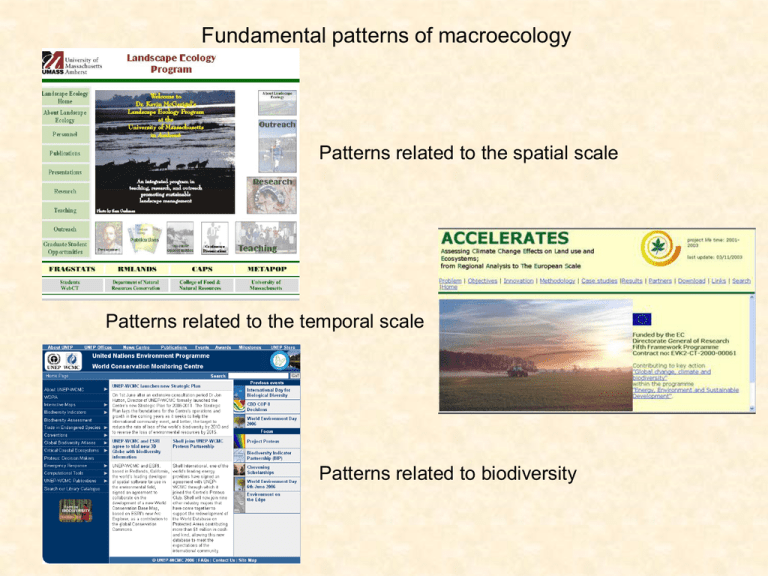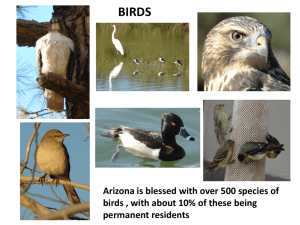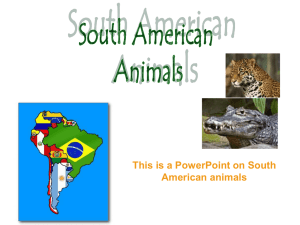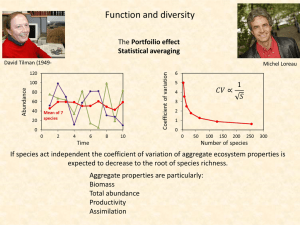Fundamental relationships in macroecology
advertisement

Fundamental patterns of macroecology Patterns related to the spatial scale Patterns related to the temporal scale Patterns related to biodiversity Patterns related to the spatial scale Single island Theory of Island biogeography Immigration Rate Extinction Robert MacArthur (1930-1972) Equilibrium species richness Edward O. Wilson (1929-) Species richness tries to understand diversity from stochastic colonization of islands. Two islands Immigration Extinction Colonization rates depend on island area and isolation Near by Rate Extinction rates depend on island area Small Large Isolated The model is species based Equilibrium species richness Species richness Theory of Island biogeography S = S0e-kI Isolation Species richness Species richness Galapagos islands S = S0f(A) Area Patterns related to the spatial scale The species – area relationship Number of species Species accumulation on seamounts in the pacific west of Australia 300 250 200 150 100 50 0 1. The number of species raises with the area under study 2. This relation often follows a power function 0.85 y =25.5x R = 0.77 0 20 40 60 80 100 Number of seamounts S= S0Az +e log S = log S0 + z logA + e 3. The slope z of this function measures how fast species richness increases with increasing area. It is therefore a measure of spatial species turnrover or beta diversity 4. The intercept S0 is a measure of the expected number of species per unit of area. It is therefore a measure of alpha diversity 5. Outliners from this pattern mark ecologcal hotspots or cold spots 6. Changes in slope through time point to disturbances like habitat fragmentation or destruction 3.2. Species area relations (SPARs) and slope reported values from various Slopes ofTab.species – area relations bystudies. various researchers Reference Sampling a community Ulrich 1998a Ulrich 1998a Ulrich 1998a Ulrich 1998a Ulrich 1998a Ulrich 1998a Ulrich 1998a Lawrey 1992 Lawrey 1992 Communities SPAR Parasitoids of Lepidoptera Parasitoids of Diptera Parasitoids of Coleoptera Hyperparasitoids Parasitoids of Aphidina Parasitoids of Cicadina All hymenopteran parasitoids Lichen communites in Maryland Lichen communites in Virginia power function power function power function power function power function power function power function power function power function 0.44 0.46 0.37 0.67 0.43 0.3 0.43 0.28 0.16 Sampling different communities of the same structure Blake and Karr 1987 Birds of Central Illinois woodlots Baldi and Kisbenedek 1999 Orthoptera in small steppe patches Coleman et al. 1982 Birds of a lake island in Ohio Nilsson et al.. 1988 Birds of islands in a Swedish lake Wright 1988 Birds of islands in a Panamanian lake logarithmic logarithmic power function power function power function 5.2 3.22 0.6 0.62 0.27 Sampling oceanic islands Wilson and Taylor 1967 Wilson and Taylor 1967 MacArthur and Wilson 1963 Harris 1973 Preston 1962 Terborgh 1973 MacArthur and Wilson 1967 Ricklefs and Lovette 1999 Ricklefs and Lovette 1999 Ricklefs and Lovette 1999 Ricklefs and Lovette 1999 Baroni Urbani 1971 MacArthur and Wilson 1963 MacArthur and Wilson 1963 MacArthur and Wilson 1963 Johnson et al. 1968 Brown 1978 power function power function power function logarithmic power function logarithmic power function power function power function power function power function power function power function power function power function power function power function 0.22 0.14 0.4 1.98 0.32 2.2 0.3 0.232 0.207 0.265 0.167 0.19 0.3 0.5 0.5 0.4 0.33 Polynesean ants Solomon islands Birds of Solomon islands Birds of Galapagos Land plants of galapagos Birds of West Indies Herpetofauna of West Indies Bats of Lesser Antilles Birds of Lesser Antilles Butterflies of Lesser Antilles Herpetofauna of Lesser Antilles Ants of tuscan archipelago Carabidae of Greater Antilles Ponerine ants of Melanesia Birds of Indonesia Vascular plants of california Islands Boreal mammals Slope Slopes of species – area relations reported by various researchers Sampling habitat islands Whitehead and Jones 1968 Rosenzweig and Sandlin 1997 Galli et al. 1976 Martin 1980 Rusterholz and Howe 1979 Nilsson et al. 1988 Nilsson et al. 1988 Nilsson et al. 1988 Sampling mainland areas Williams 1964 Williams 1964 Begon et al. 1986 Reichholf 1980 Preston 1960 Preston 1960 Harner and Harper 1976 Judas 1988 Ulrich 1999c Kapaminga atoll Tropical freshwater fishes Birds in small woods in New Jersey Great Plain birds Birds from Minesota lakes Carabidae of islands in a Swedish lake Woody plants of islands in a Swedish lake Land snails of islands in a Swedish lake power function power function power function power function power function power function power function power function 0.1 1.36 0.39 0.41 0.44 0.36 0.1 0.15 Flowering plants Great Britain Land plants Great Britain Mediterranean birds Middle european birds Nearctic birds Neotropical birds Vascular plant species of Utah and new Mexico European Lumbricidae European Hymenoptera power function power function power function power function power function power function 0.1 0.16 0.13 0.14 0.12 0.16 power function 0.19 power function power function 0.09 0.11 Empirical conclusions • Most regional SARs are best described by a power function model • Island slopes z of the power function are mostly higher than mainland slopes • Island slopes are in the order of 0.2 to 0.6 • Mainland slopes are in the order of 0.1 to 0.3 • Slopes of local SARs are higher than those of regional SARs How to explain SARs? •Passive sampling •Habitat diversity •Area per se •Fractal geometry Passive sampling 206 91 1895 3450 102 342 505 102 342 505 55 829 89 1410 55 829 89 1410 160 149 325 1704 160 149 325 1704 206 91 1895 3450 206 91 1895 3450 Assume a number of sites randomly colonized (occupied) by individuals of a number of species. 102 342 505 102 342 05 The abundances of the 5colonizing metacommunity need not to differ in abundances but most often 8they do. 55 29 89 1410 55 829 89 1410 The probability tha a species i is not found in the k120 160 1 4 9 n is3 2 5 1704 th patch area of a patch k, 1 6 0 is (a 1 4k9 is the 3 2 5 relative 1704 i 100 the number of individuaks of species i. p i (k ) (1 a k ) 91 1895 3450 206 ni 91 The probability to find a member of i and 102 342 505 therefore this species is then 55 29 1410 p i8(k ) 8 91 (1 ak) ni The rise of1 4species richness S(a) with area is 160 9 325 1704 a then given by (Coleman et al. 1982) 206 91 1895 S 3450 S(a ) S total (1 a k ) i 1 1895 S 206 ni 80 3450 60 40 20 0 0.01 y = 81x0.05 0.1 1 10 Area Passive sampling predicts an increase of species richness with area. The slope of this increase is lower than observed in nature. Tab. 3.3 Results of multiple regression of the logarithm of species richness diversity. habitat per on island area and Area se and habitat diversity Faunal groups of the Lesser Antillean (Ricklefs and Lovette 1999) Habitat Significance Significance Area Number of diversity Faunal group value value slope samples slope 0.074 < 0.05 0.126 < 0.05 19 Birds 0.087 > 0.05 0.375 < 0.05 17 Bats 0.128 <0.0001 0.026 > 0.05 19 Herpetofauna 0.116 < 0.05 0.139 > 0.05 15 Butterflies 31.73333333 28.73333 60.46667 Stepwise multiple regression shows how various factors influence species numbers of mammals in South America (Ruggiero 1999) F actor b A rea 0.94 N et prim ary productiv ity 0.01 Latitude 0.73 S um m er precipitation 0.2 W inter precipitation -0.35 S um m er tem perature 0.71 W inter tem perature 0.7 R ichness of v egetation 0.74 V ariability in sum m er precipitation -0.41 V ariability in w inter precipitation-0.48 V ariability in sum m er tem perature 0.21 V ariability in sum m er tem perature 0.22 R 2 0.86 0.46 0.42 0.4 0.46 p 0.0006 0.99 0.04 0.64 0.39 0.05 0.05 0.04 0.31 0.23 0.62 0.59 How to assess diversity patterns? Grid approach Species richness within each grid is assessed from Museum collections. Environmental data come from Satellite images. An important variable is the distance between grid cells: Spatial autocorrelation How to infer large scale patterns? Species richness of European bats for 58 European countries and larger islands (Ulrich et al. 2007) S 100 10 Formulating a linear regression model S V A b1 L b 2 D b3 H b 4 T b 5 N T 0 z SV A 0.20 0.01 (0.63 0.11) L (0.64 0.08) T SV A 0.19 0.01 (0.52 0.09) L (0.30 0.08) T A Azores 0.19 ( 0.16 0.07 ) L Iceland Cyclades 1 1 100 10000 1000000 Area 25 Croatia 20 S 15 10 5 0 -5 -10 20 30 40 50 Latitude 60 70 80 Vespertilio murinus SARs and fractal geometry In 1999 John Harte and co-workers asked whether thre is a common theme behind the spatial distribution of all plant and animals species. They argued that fractal geometry might explain observed patterns in the abundance and distribution of species Using a probabilistic argument they showed that S S0A z E E 0A Graphic: Jean-Francois Colonna SAR 1 y EAR, Endemics – area relationship Subsequent studied showed that this holds only approximately, but reasonably well Important: Spatial distribution of single species is self similar The fractal dimension of each species can be used as a species fingerprint. Cerro Grande Wildfire / Weed Map How to use SARs? SARs are used to estimate species Estimating species numbers numbers and to detect ecological hotand cold spots The mean number of bird species in Poland [312685 km2] 8 7 6 ln(S0)+CL0.95 5 ln S is about 350, the total European [10500000 km2] species number is about 500. How many species do you expect for the Czech Republic [78866 km2]? +a 4 -a 3 S S0A z 2 ln(S0)-CL0.95 1 0 0 2 4 6 8 10 ln S ln Area 8 7 6 5 4 3 2 1 0 SLO MAZ AL CH A FL 6 SC 8 10 12 14 16 2 ln Area [km ] ln end. species B MAZ 4 L 3 FL CAN 0 4 6 8 SC SA z SC ln(440) ln(800) ln(312685) ln(10500000) 0.17 z 440 (312685 / 78688) 0.17 348 The true number is about 380. We extrapolated outside the range for which the SAR was defind by our data. 2 1 z A A AC SA (A A / A C ) z What causes the higher number of birds in the Czech Republic? 6 5 ln(A A ) ln(A B ) RUS AZO A A AB ln(S A ) ln(S B ) z IRL 4 SB S S0A TRA AND MAD z SA IRL N 10 12 2 ln Area [km ] 14 16 The estimate of the European number is very imprecise. Species - area relationship of the world birds at different scales 10000 Number of species between biotas: z = 0.53 1000 100 within a regional pool: z = 0.09 10 small areas: z = 0.43 1 1.0E-01 1.0E+01 1.0E+03 1.0E+05 1.0E+07 1.0E+09 1.0E+11 1.0E+13 Area [Acres] The species – area relationship of plants follows a three step pattern as in birds Number of species 1000000 100000 Intercontinental scale: z = 0.5 10000 1000 100 10 Regional scale: z = 0.14 Local scale: z = 0.25 1 1.E-04 1.E-02 1.E+00 1.E+02 1.E+04 1.E+06 1.E+08 1.E+10 1.E+12 2 Area [km ] Today’s reading SAR: http://math.hws.edu/~mitchell/SpeciesArea/speciesAreaText.html Theory of Island biogeography: http://books.google.pl/books?id=yRr4yPSyPvMC&dq=Theory+Island+biogeogr aphy&printsec=frontcover&source=bn&hl=de&ei=HsibSbSJEdSujAfZ7qS9BQ& sa=X&oi=book_result&resnum=4&ct=result#PPA4,M1 Ulrich W., Buszko J. 2005. Detecting biodiversity hotspots using species - area and endemics - area relationships: The case of butterflies. Biodiv. Conserv. 14: 1977-1988 pdf Ulrich W., Buszko J. 2003b. Species - area relationships of butterflies in Europe and species richness forecasting. Ecography 26: 365-374. pdf








